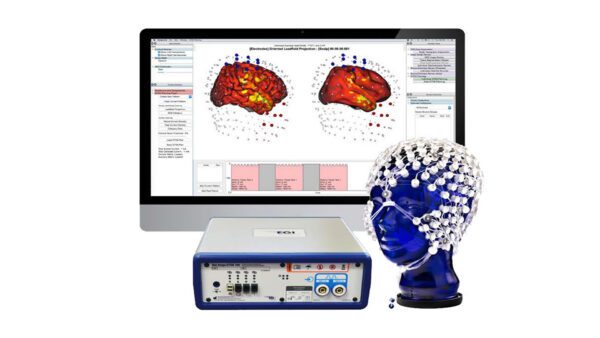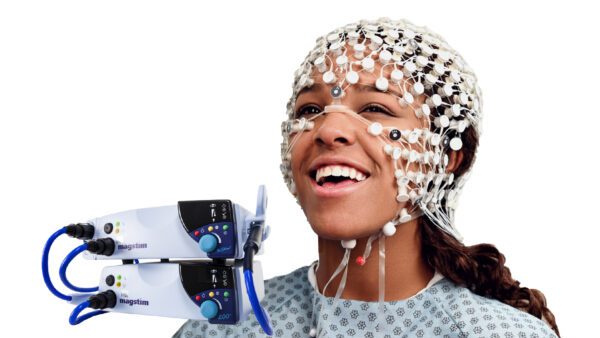GTEN 200
Geodesic Transcranial Electrical Neuromodulation 200
(GTEN 200)*
Record HD EEG and deliver current simultaneously using the same Geodesic Sensor Net
- Options for 64, 128, or 256 channel sensor nets allowing any electrodes to serve as anodes, cathodes or recording electrodes
- Up to 2 mA current intensity for custom HD tDCS, tACS, tPCS, and tRNS protocols
- Individualized head modeling and a library of age-matched atlases
- Source localization tools (LORETA, sLORETA, LAURA)
- Software Developer’s Kit (SDK) included for free
Specifications
Create an MR-based individualized head model or select an age-matched atlas
- Account for intersubject differences from the start
Design your custom stimulation protocols in one of three ways:
- Manually select electrodes and current level
- Choose a region of interest within the brain to target
- Use EEG-based source localization to guide the stimulation paradigm
Localize with confidence
- High density, whole head electrode coverage and finite difference method head models allow for highly accurate source localization
Apply the reciprocity theorem to align stimulation with physiology
- A cortical source’s scalp voltage projection is the same as the scalp stimulation required to stimulate/modulate that cortical source 1
Localize targeting by selecting, combining custom stimulation arrays
- Up to 256 channels of EEG, of which 190 channels can be used for stimulation, with spatial selectivity to stimulate multiple anodal/cathodal pairs at a given time (minimum of 10 pairs needed to achieve maximum current)
Achieve greater focality with smaller stimulation sensors
- 1cm2 enables 0.2mA/cm2 current density in patch electrodes
Measure the targets and effects with HD EEG
- Use EEG-based source localization to guide the stimulation paradigm and seamlessly record EEG while stimulating
Close the loop and change protocols in real-time driven by physiology
- Use the Software Developers’ Kit (SDK) and other open-source platforms to develop and perform closed-loop neuromodulation
Current concentration at the electrode is higher with smaller electrodes and has been shown to achieve more focal stimulation.
The Geodesic Transcranial Electrical Neuromodulation (GTEN)* system is a unique and powerful research platform combining noninvasive neuromodulation with HD EEG.
The technology behind GTEN 200 Neuromodulation
EGI’s study using GTEN 200 Research System and pulsed protocols showed long-term depression of motor cortex excitability, sustained over 90 minutes following current injection Luu et al. (2016). Slow-Frequency Pulsed Transcranial Electrical Stimulation for Modulation of Cortical Plasticity Based on Reciprocity Targeting with Precision Electrical Head Modeling. Front Hum Neurosci, 10, 377.
The GTEN 200 Neuromodulation technology uses the reciprocity principle, which allowed EGI to develop a superior method for selecting electrodes for current injection for a given target. Fernandez-Corazza, et al. (2016). Transcranial Electrical Neuromodulation Based on the Reciprocity Principle. Front Psychiatry, 7, 87.
High resolution head models
Realistic high resolution head models are critical for the most accurate neuromodulation planning algorithms. EGI uses Finite Difference Method (FDM) head models.
Good conductivity estimates and good geometry descriptions in the head model improve the accuracy of source localization. Song, et al. (2013). Anatomically accurate head models and their derivatives for High Density EEG source localization. Funct Neurol Rehabil Ergon, 3(2-3), 275-293.
A dense array of electrodes with whole head coverage, including the neck and face regions, is critical for accurate source analysis. Song et al., (2015) EEG source localization: Sensor density and head surface coverage. J Neurosci Methods, 256, 9-21.
EGI head models and source estimation correctly identify a small known area of the motor cortex. Kuo, et al. (2014). Localizing movement-related primary sensorimotor cortices with multi-band EEG frequency changes and functional MRI. PloS one, 9(11), e112103.
Based on this research, we integrated High Density EEG and the best head models into GeoSource Research products to create what we believe to be the most accurate source estimation product available. We tested the ability of GeoSource source estimation to identify a small known area of the motor cortex, and were able to show localization to a known anatomical location, as well as comparable results to fMRI studies (Kuo et al., 2014).
Creating individual head models
To create conformal or individual FDM head models, GeoSource electrical source imaging and GTEN 200 neuromodulation system use a step-by-step workflow that takes a fraction of the time typically required for this level of accuracy. Li, K., Papademetris, X., & Tucker, D. (2016). BrainK for Structural Imaging Processing: Creating Electrical Models of the Human Head. Computational Intelligence and Neuroscience, 2016, Article ID 1349851.
*Geodesic Transcranial Electrical Neuromodulation 200 (GTEN 200) System is not intended for use in diagnosis or treatment of any disease or condition. It is a scientific research instrument designed for performing measurements and acquiring data for neurophysiological research. MagstimEGI makes no representation of the suitability of the instrument for any particular research study.
Noninvasive Electrical Neuromodulation
GTEN 200
- Luu P, Essaki Arumugam EM, Anderson E, Gunn A, Rech D, Turovets S and Tucker DM (2016) Slow-Frequency Pulsed Transcranial Electrical Stimulation for Modulation of Cortical Plasticity Based on Reciprocity Targeting with Precision Electrical Head Modeling. Front. Hum. Neurosci. 10:377. doi: 10.3389/ fnhum.2016.00377
EGI’s work is covered by several patents and patents pending. Net Station 5.4, GeoSource 3, and GTEN 200 products are protected by one or more of the following issued US patents: 6,330,470, 6,594,521, and 9,326,699. GeoSource Research products are protected by one or more of the following US patents: 8,478,011.
Contact Us
Contact us









